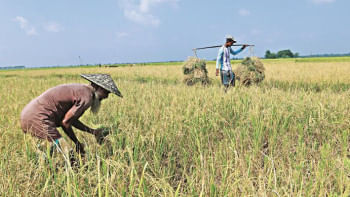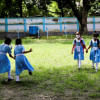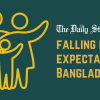Bangladesh’s population hits 175.7 million

Bangladesh's population has reached 175.7 million, two thirds of which, around 115 million, are of working age, between 15 to 64.
The estimation was made by the United Nations Population Fund's (UNFPA) annual flagship publication, the State of World Population (SWOP) 2025.
UNFPA Representative in Bangladesh Catherine Breen Kamkong officially launched the annual report at a press event held at the UN Building in the city's Gulshan area today.
"As of 2025, the global population stands at 8.2 billion. Bangladesh's population is estimated at 175.7 million of which half are women, two-thirds (115 million) are in the working-age group. It is an opportunity to harness the demographic dividend," said Catherine Kamkong.
At the same time, 7 percent (12 million) of the population is aged 65 and above, signalling the onset of population ageing, she said.
Adolescents make up 19 percent of Bangladesh's population, approximately 33 million, while the broader youth cohort aged 10-24 accounts for 28 percent, nearing 50 million, Catherine Kamkong added.
Talking about this year's theme of the publication, "The Real Fertility Crisis – The Pursuit of Reproductive Agency in a Changing World," she said it challenges the dominant narrative of "too many" or "too few" births.
The real crisis is not about numbers, it is a crisis of reproductive agency, she said.
"Around the world, and here in Bangladesh, people especially women and young people are unable to realise their reproductive intentions due to systemic, economic and social barriers," said the UNFPA representative.
The report is based on a global survey conducted by UNFPA, complemented by academic research and the lived experiences of communities, offering a rich and diverse perspective on fertility and reproductive agencies.
In high-income countries like the Republic of Korea, fertility has dropped to just 0.8 children per woman, the lowest globally.
In contrast, some African countries continue to experience high fertility rates, with Niger recording the highest total fertility rate (TFR) at 5.8 children per woman, as per the report.
The report shows that Bangladesh falls in between, with a TFR of 2.1.
In parts of Bangladesh, adolescent birth rates remain high, fueled by early marriage, limited access to contraception, and a lack of sexuality education.
The report sheds light on unfulfilled fertility aspirations, backed by evidence from 14 countries.
While most people desire two children, many have fewer than they wish, especially older adults, while others anticipate having more than planned and lack the knowledge or the means to access family planning services.
In Bangladesh, Catherine Kamkong said, there is high out-of-pocket expenditure for health, meaning that people that do not have the financial means might not be able to access the care they need.
"In Bangladesh, the government currently invests only 0.7 percent of GDP and 2 percent of the common budget for health. We hope that will be increased to 5 percent of GDP and 15 percent of the common budget as the health and well-being of Bangladesh is crucial for harnessing the future potential of the country," she said adding that this will enable the recruitment, deployment and retention of skilled health workforce including midwives across the country.
It will also enable uninterrupted supply of life saving medicines and a variety of contraceptives which give women choice, she added.

 For all latest news, follow The Daily Star's Google News channel.
For all latest news, follow The Daily Star's Google News channel. 










Comments